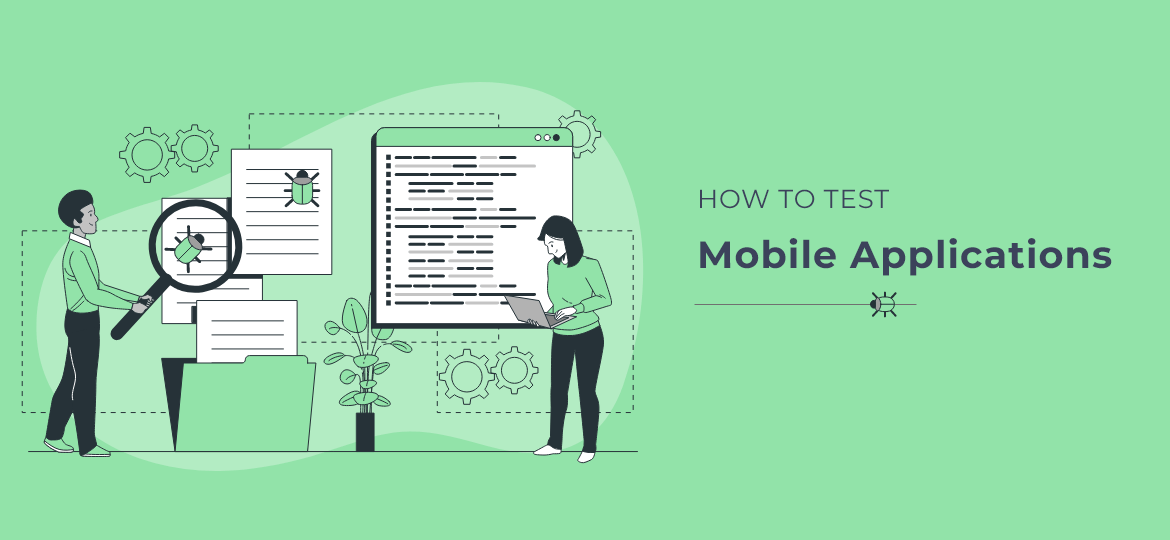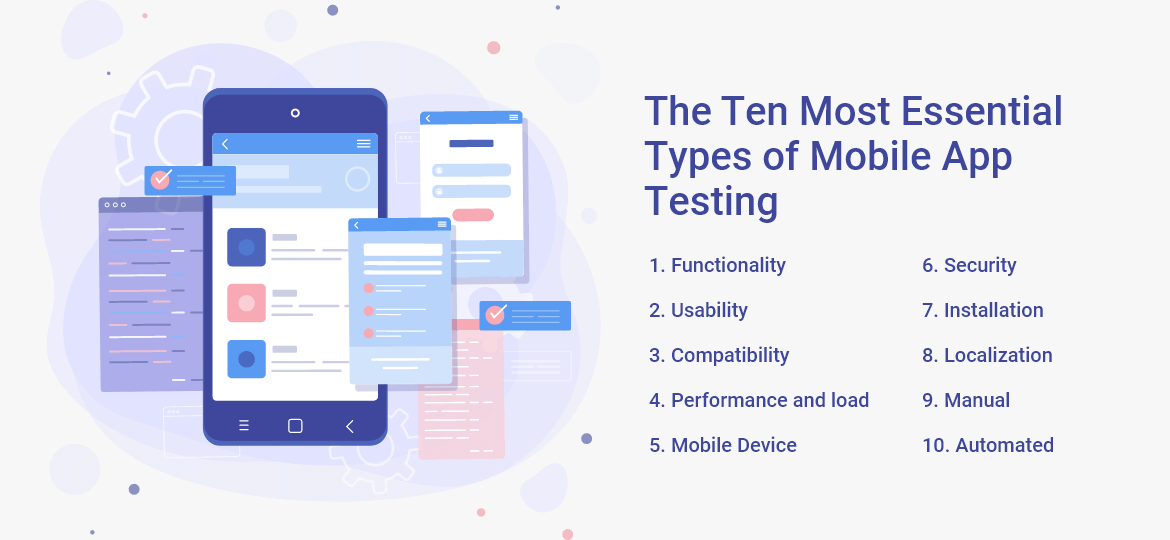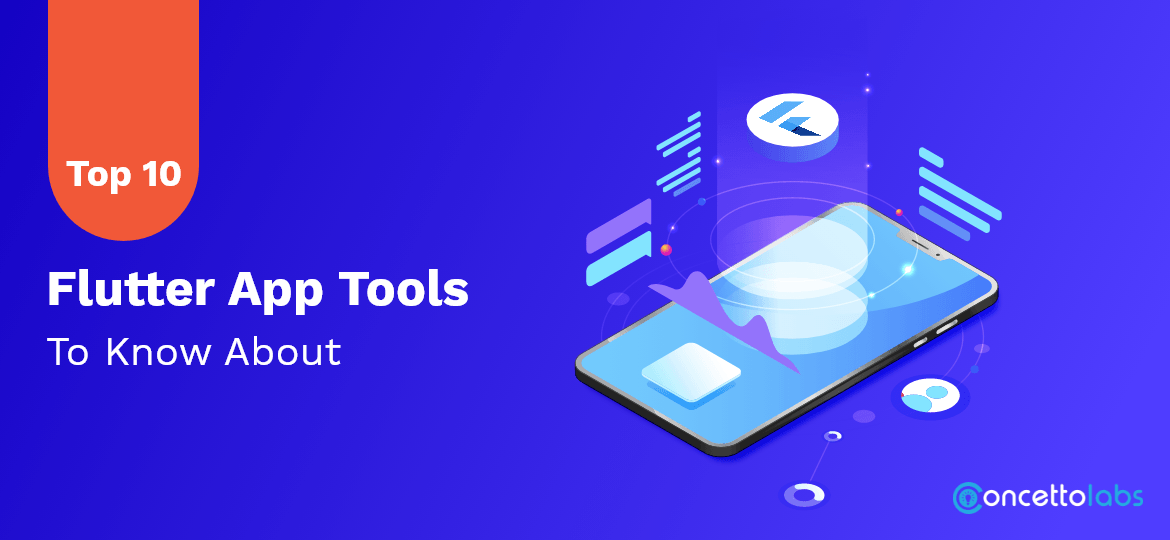
Mobile app development is a service we will forever need due to the increase in mobile device users globally. Today, there is an app for almost everything, which makes life extremely convenient for users. One reason why these apps can satisfy users so well is that they function perfectly, just as the developing company intends them to do. But have you wondered how does an app used in multiple countries, languages, devices, and systems get to work so well? The credit goes to mobile application testing, which ensures all aspects of the app works as intended. If you’re wondering how to test a mobile app, this blog is the right place to be! We’ll be exploring how to test apps and the top ten ways to go about it.
The Ten Most Essential Types of Mobile App Testing

Jump Down:
1. Functionality
2. Usability
3. Compatibility
4. Performance and load
5. Security
6. Installation
7. Localization
8. Manual
9. Automated
10. Mobile Device
1. Functionality
Functionality software testing makes sure that your mobile app is functioning accurately. This kind of test concentrates on the main objective and function of the application so that all the attributes are responsive and are accurate as per the developer’s specifications.
It is beneficial for you to remember that only 4 out of 100 dissatisfied customers will report a bug directly to the organization while the 96 others will skip your app without any feedback. Since it can cost seven times more to get a new customer than retain the existing ones, make sure to unlock their silence and ask for reviews. Beta version subscriptions become part of the functionality testing program.
Before you test a mobile application and its functionality, make sure to check the following areas for any inconsistencies:
- The mobile app installs and opens correctly
- The users can sign-up and sign-in
- Text boxes, gestures, and buttons work accurately
- Push notifications correctly render
2. Usability
Usability testing is so-called user experience testing. It assesses the user-friendliness of the app based on the ease of use and its intuitive functionality. Generally, usability tests comprise the complete application-driven customer experience, the detection of bugs, and recommended ways to enhance the Cx, both in-app and outside the app.
Testing a mobile app for whether or not the end-to-end in-app user experience is top-notch. Real people must participate in the app usability testing with real devices to find out and repair any issues before the app release.
This kind of testing is more of a creative endeavor than science and needs talented QA usability testers to undertake tests and capture details that would affect the customers and users of the app.
The following are a big part of usability testing:
- Design and layout and
- Intuitiveness
- Response time
Most app users want the app to open in less than two seconds as soon as they launch it. Since usability testing is subjective, one needs to grasp the needs of their target audience and their user preferences. You can consider requesting them to take the test for better results.
3. Compatibility
This is a kind of non-functional test for mobile apps that is essential to make sure that an app works on all the operating systems, applications, devices, network ecosystems, and with specific internal hardware requirements.
Specifically, look out for:
- Whether the app is compatible with multiple OS and their versions.
- That the app works appropriately with different networks and their bandwidth, operating speed, and other parameters.
- If the application works on multiple web different browsers like Chrome, Edge, Safari, etc.
- Whether the app can adjust to different devices and their varying dimension, processing power, and memory.
There are also two kinds of tests mobile applications need incompatibility:
- Backward: test mobile application behavior using older versions of software
- Forward: testing a mobile app’s behavior on new versions of software including beta releases.
4. Performance and load
This kind of test assesses how aptly the mobile app performs when given a specific workload. A mobile app performance test is necessary to make sure that the app is not malfunctioning.
Don’t know how to test mobile app performance? Here’s what you should be looking out for in performance and load testing:
- Device performance: Start time, battery usage, memory use
- Network performance: Delays and errors in getting information
- API and Server performance: How promptly data gets transmission and in which format.
Additionally, your mobile application needs to comprise a built-in backup and recovery feature to save and recover user data if it gets erased.
5. Security
80 percent of mobile app users uninstall their app due to security threats. This makes security testing critical for one to understand the importance of a user’s data security.
From Bumble to food apps, many of them need users’ personal information. If your app needs the same, you have to mandatorily guarantee the privacy, authenticity, confidentiality, and integrity of the application. That’s why you should Hire QA Tester/Engineer if you don’t have one to prioritize user data security and test the app’s behavior under multiple device permission models.
6. Installation
Installation testing is also called implementation testing and is performed to assess whether the software installs and uninstalls properly.
Moreover, installation testing makes sure that the updates are loaded uninterrupted and are installed error-free. This also needs one to understand the consequences when the user does not update the app for several versions.
7. Localization
From language translation automatically as per the location to converting the currencies and following local legislation and regulations, it is critical to make sure the mobile app is available and usable in all the concerned markets. This is what localization testing ensures.
Consumers are known to skip past apps that have misaligned graphical or UI elements that can’t gel with their culture, device accessibility, or language. They expect a seamless experience that is localized as per their preferences. If you want to beat your competitors, completely localizing apps is the way to go.
Related: The Mobile App Testing Strategies That Concetto Labs Follows
8. Manual
A manual test for mobile apps is a long process that involves multiple skill sets and mechanisms.
Hire QA analysts and teams to conduct manual testing so your final product works as you intend it to. With a particular function, manual tests explore use-cases that are hidden beneath the surface. Expert QA analysts testing in short breaks durations to hoard the mobile app can find exceptional results.
These tests cannot be automated because they would destroy the purpose of manual testing.
How to test an app manually? Here’s what to focus on:
- App’s physical interface
- Complex testing
- Exploratory tests
9. Automated
There are a few instances where manual testing is preferable. Although, some QA tests can become too complex and painstaking for human analysts. This is why smartly conducted auto testing conducted with manual tests can help you roll out high-quality apps quickly.
IF you’re wondering what the automated testing best practices are, here are a few:
- The design of the app: It’s build and maintenance of test scripts accuracy
- The integration and alignment of present DevOps workflows with the testing procedure.
- Creating and maintaining the test automation framework. This consists of test automation infrastructure as well.
- Managing test setups and runs.
- Meticulous reviewing to find bugs and rectify them
- Careful analysis and quick response to flakey testing.
10. Mobile Device
Mobile apps need to be tested for their compatibility with hardware and operating systems. There are many testing methods for mobile hardware and software that look like the following:
- Interruptions: This test detects the app’s activity when it is interrupted and the efficiency with which it resumes its prior function. Interruptions can be the phone dying due to drained battery, loss of network, updates, sudden reboots, and system glitches.
- Location-based Services (LBS): This feature uses geographic-data mobile devices. Location-based services help provide real-time data, security, or entertainment to users. These can also be seen in apps like Facebook and Instagram where users can check into particular places or venues while visiting them.
- Biometrics: Many mobile devices have biometric detectors like fingerprint analysis, face scanners, retina scanners, insulin levels, and DNA scanners.
- NFC payments: Near Field Communications (NFC) taps allow mobiles to transfer and receive money using a payment terminal for contactless payments.
Conclusion:
As software testing services and mobile app testing become even more critical for the success of an app, you need experts by your side! Concetto Labs is the best mobile app development company you can rely on for all your app curation needs, including testing. Our rigorous standards ensure not a single big goes by without detection! Want happy app users? Contact Concetto Labs today!






 Indonesia
Indonesia
 Botswana
Botswana
 USA
USA
 Italy
Italy
 Panama
Panama




 USA
USA UK
UK Saudi Arabia
Saudi Arabia Norway
Norway India
India Australia
Australia